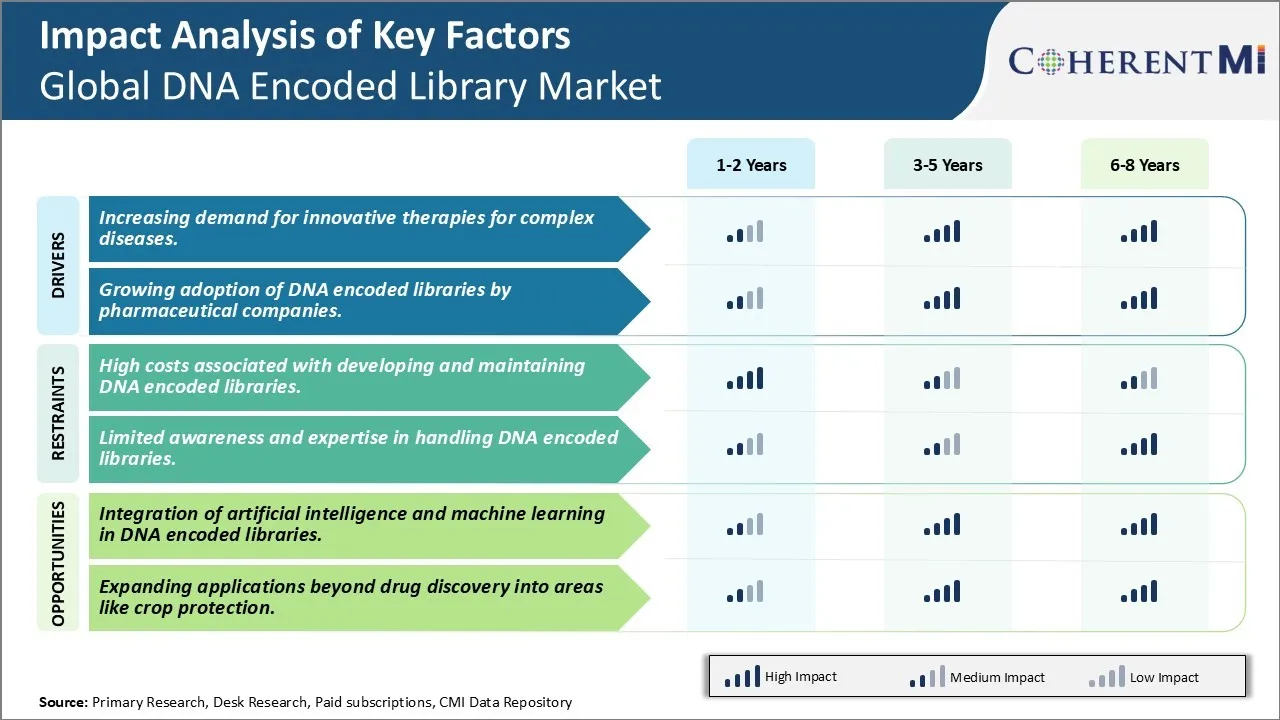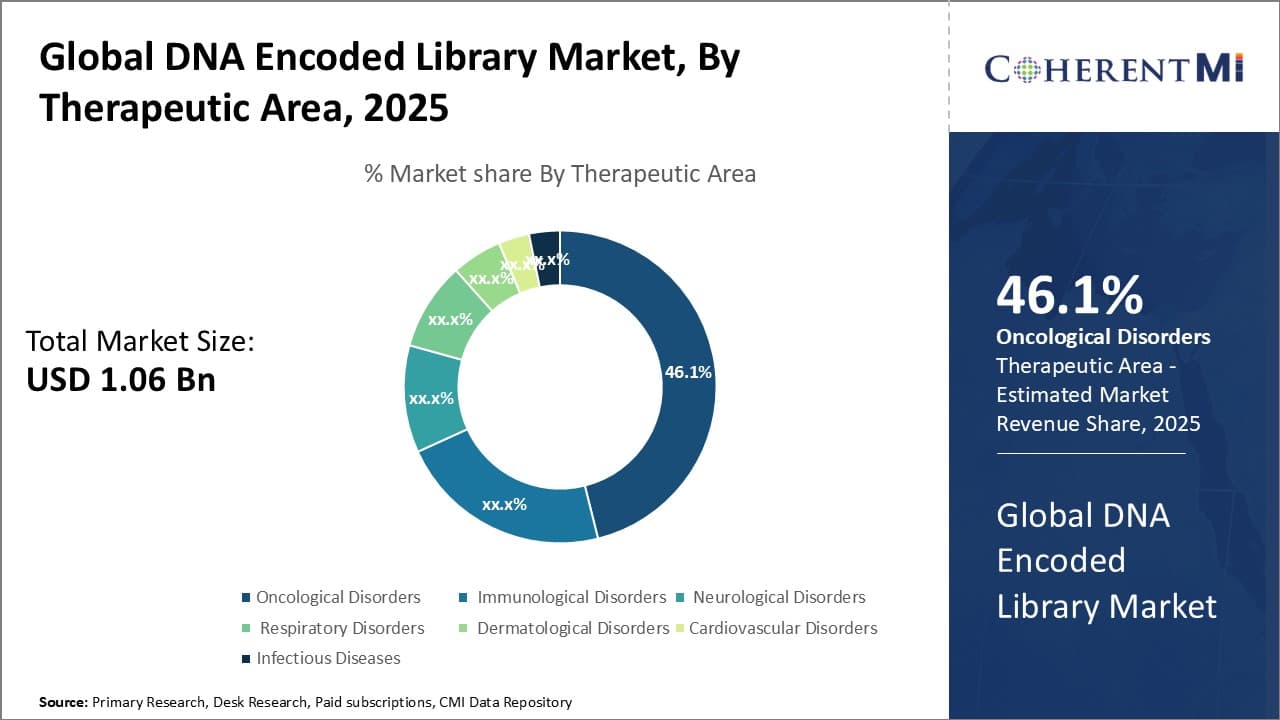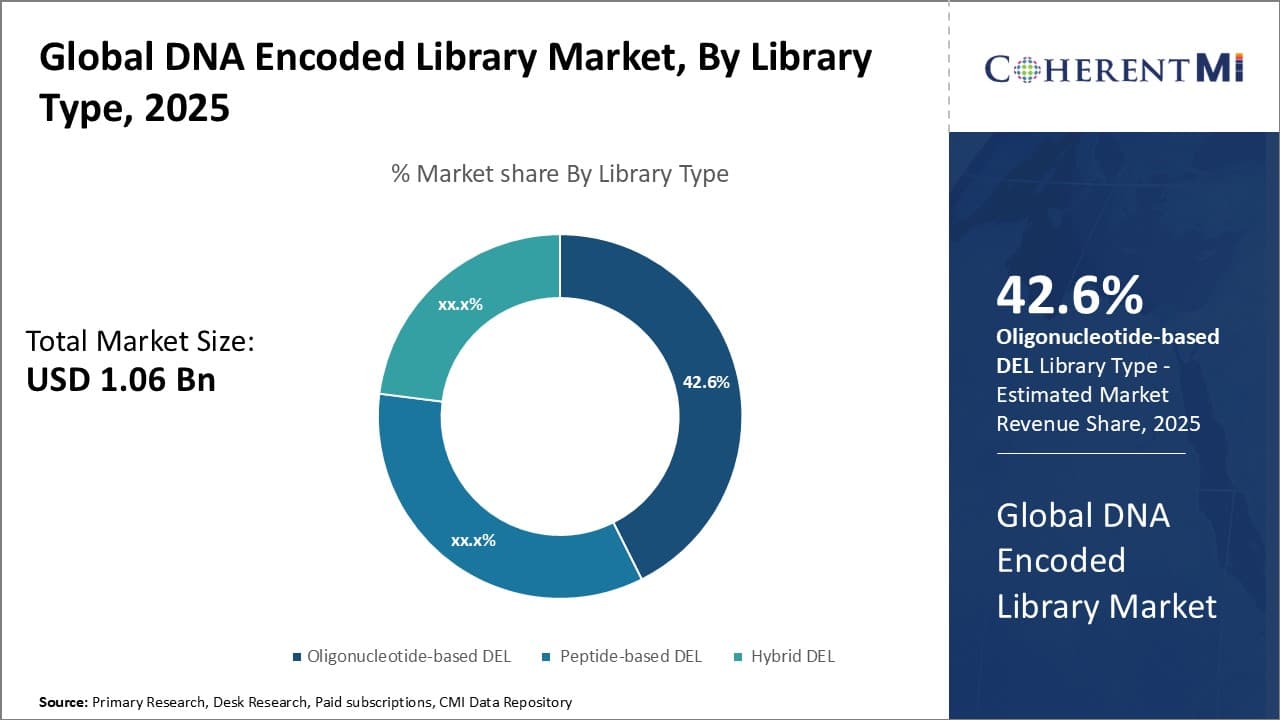Global DNA Encoded Library Market Size - Analysis
The Global DNA Encoded Library Market is estimated to be valued at USD 1.06 Billion in 2025 and is expected to reach USD 3.11 Billion by 2032, growing at a compound annual growth rate (CAGR) of 16.6% from 2025 to 2032. The DNA encoded library market has been witnessing significant growth over the past few years owing to rising investments in pharmaceutical R&D and increasing adoption of DNA encoded libraries by pharmaceutical companies to accelerate drug discovery process.
The DNA encoded library market is expected to witness rapid growth during the forecast period due to increasing investment in genomics and biotechnology sector. DNA encoded libraries have emerged as an innovative technology that has enabled rapid screening of large chemical spaces for potential hit identification. Many big pharmaceutical companies are investing heavily in development of proprietary DNA encoded libraries to screen vast chemical spaces and identify new small molecule hits that can become therapy or drug candidates. The advantages of DNA encoded libraries such as large scale compound testing, rapid hit identification and lower costs compared to traditional high throughput screening are driving their demand among pharmaceutical companies. Additionally, continuous technology advancements to develop more efficient DNA encoding techniques are further expected to boost the market during the forecast period.
Market Size in USD Bn
CAGR16.6%
| Study Period | 2025-2032 |
| Base Year of Estimation | 2024 |
| CAGR | 16.6% |
| Market Concentration | High |
| Major Players | BOC Sciences, DyNAbind, Edelris, GenScript, HitGen and Among Others |
please let us know !
Global DNA Encoded Library Market Trends
Market Driver - Increasing demand for innovative therapies for complex diseases
The healthcare sector is constantly evolving to address the growing threat of complex diseases. Traditional methods of drug discovery are often unable to keep up with the pace of emerging illnesses. This has created a sizable gap in effective treatment options for conditions like cancer, autoimmune disorders, and rare genetic maladies. Patients desperately need novel therapies that can target the root causes with greater specificity and fewer side effects. DNA encoded libraries have emerged as a promising solution to fulfill this increasing demand.
By allowing rapid screening of millions of drug-like small molecules in parallel, DNA encoded libraries give researchers an unprecedented level of experimental throughput. This accelerates the discovery of hits that engage disease targets in precise ways.
Researchers can now evaluate molecular interactions across entire biological pathways as opposed to focusing on just individual proteins. This systems-level approach presents new opportunities to address complex multi-factorial conditions by modulating multiple nodes simultaneously. DNA encoded libraries also enable evaluation of compounds that were previously inaccessible through conventional synthesis methods, expanding the potential chemical space for novel treatment options.
Clinicians, care providers, and patient advocates actively campaign to accelerate the development and approval of advanced therapeutics that improve outcomes and quality of life. Their voices help shape policy reforms and increase public/private investments in innovative research.
As diseases continue spreading to growing populations worldwide and overcoming traditional drugs, society expects biopharma to rise up and fulfill this need through cutting-edge strategies like DNA encoded libraries. Their ability to efficiently explore vast pools of synthetic and natural compounds positions them at the forefront of next-generation precision medicine efforts aimed at complex diseases. This confluence of societal pressures and scientific promise will continue driving increased adoption of the technology.
Growing Adoption of DNA Encoded Libraries by Pharmaceutical Companies
The pharmaceutical industry is under constant pressure to replenish dwindling pipelines as many major drugs lose patent protection each year. Developing novel therapeutics is a resource-intensive process often taking over a decade with extremely low odds of success. Companies are eager to integrate emerging techniques that can hasten the journey from target identification to clinical candidates. DNA encoded libraries are garnering strong interest from industry players for their unique capability to rapidly generate high-quality lead molecules against challenging targets.
Contrary to conventional high-throughput screening technologies relying on synthesized small-molecule collections, the flexibility of DNA encoded libraries allows exploration of exponentially larger and more diverse chemical space in parallel.
Pharma R&D centers are able to perform multiplexed experiments involving millions of compounds in a cost-effective manner. Initial library configurations may focus on privileged structures or natural product-like scaffolds to increase hit rates against difficult targets. DNA encoding further enables late-stage compound optimization and profiling directly within the library format itself without separate synthesis.
Major players like AstraZeneca, Novartis, Sanofi, and Janssen have already begun establishing internal DNA libraries and developing associated expertise. Contract research organizations specializing in the technology are also witnessing a surge in pharma collaborations and outsourced projects.
Over time, DNA encoded library screenings are expected to become a standard first-pass evaluation strategy incorporated earlier into drug development workflows. Emerging applications going beyond simple target engagement now involve in vivo animal studies, biomarker analyses, and resistance profiling. As successful proof-of-concept studies establish real-world clinical and commercial validation, adoption rates within the industry are poised to rapidly accelerate.
 To learn more about this report,Request Sample Copy
To learn more about this report,Request Sample Copy
Market Challenge - High costs associated with developing and maintaining DNA encoded libraries
One of the key challenges currently facing the global DNA encoded library market is the high costs associated with developing and maintaining DNA encoded libraries. Creating DNA encoded libraries at scale requires significant investments in technology, infrastructure and skilled personnel. The process of developing a DNA encoded library starts with designing and synthesizing large pools of compounds that are then attached to DNA tags through chemical ligation. This process of creating millions to billions of DNA-encoded molecules is complex and resource intensive. It involves the use of expensive DNA synthesizers, reagents and other laboratory equipment.
Maintaining and screening DNA encoded libraries over time also leads to continuous costs. As libraries are used in assays and experiments, some molecules may degrade or get lost, requiring replenishment or expansion. Libraries also need to be characterized regularly to ensure diversity and quality are maintained. All these activities associated with developing, refining and upkeeping DNA encoded libraries over the long term make it a costly endeavor for players in this market. The high capital requirements pose a major challenge, especially for smaller companies and startups with limited budgets. This cost barrier could potentially limit further innovation and growth in applications of this promising technology.
Market Opportunity- Opportunities through Integration of artificial intelligence and machine learning in DNA encoded libraries
One of the key opportunities in the global DNA encoded library market is through greater integration of artificial intelligence and machine learning technologies. As DNA encoded library datasets continue to grow in size and complexity, there is potential to leverage AI/ML to help optimize the libraries and discovery processes. AI/ML algorithms could be used to glean insights from vast amounts of sequencing and screening data. They could help recommend new compounds for synthesis, refinement of library design, and prognostication of biologically relevant molecules.
As assays become higher throughput, AI/ML models may assist with automated analysis of large output datasets. They could also power in silico screening to propose molecules for experimental validation. Pharmaceutical companies are also exploring using AI/ML approaches like generative models to propose entirely new DNA encoded libraries. If successfully applied, AI/ML technologies have the potential to make library design and candidate selection more efficient. This could help accelerate discovery timelines and lower costs. Increased AI/ML integration therefore presents an opportunity for the DNA encoded library market to enhance the entire workflow from creation to downstream applications.
Key winning strategies adopted by key players of Global DNA Encoded Library Market
Diversification of Library Designs - Many major players like Novartis, Astex Pharmaceuticals and Ambit Biosciences have diversified their DNA encoded library designs to screen for targets beyond kinases. They have developed novel libraries aimed at G-protein coupled receptors (GPCRs), protein-protein interactions and epigenetic targets. This helped expand their customer base and increased adoption of their platform technologies.
Acquisitions for Technology Leadership - In 2017, AstraZeneca acquired Astex Pharmaceuticals, a pioneer in DNA encoded library technology, for $1.6 billion. This strengthened AstraZeneca's position as a leader in this space. Similarly, Novartis acquired Encoded Genomics in 2019 to gain access to their proprietary DNA-encoded chemical library platform. Such acquisitions helped companies stay ahead of competition through access to advanced technologies.
Partnerships for Screening Expertise - Smaller players who lacked in-house screening capabilities partnered with contract research organizations (CROs) to leverage their expertise. For example, Anthropic partnered with Charles River Laboratories in 2018 for high-throughput screening of their AI-designed DNA encoded chemical library. This helped Anthropic to screen thousands of compounds efficiently despite limited resources.
Open Innovation Models - Companies like Repare Therapeutics adopted an open innovation approach and partnered with academic research institutes to identify novel targets. Their partnership with The University of Texas MD Anderson Cancer Center in 2021 led to discovery of potential drug candidates against previously undruggable oncogenic targets. Such strategies enhanced credibility in the research community.
Focus on Therapeutic Areas of Unmet Need - Players invested most resources in areas with high unmet clinical needs like oncology, neurology and antimicrobial resistance where success rates are higher. For example, combinations of Novartis.
Segmental Analysis of Global DNA Encoded Library Market
 To learn more about this report,Request Sample Copy
By Therapeutic Area - The Rising Prevalence of Cancer Drives the Growth of Oncological Disorders Segment
To learn more about this report,Request Sample Copy
By Therapeutic Area - The Rising Prevalence of Cancer Drives the Growth of Oncological Disorders Segment
In terms of By Therapeutic Area, Oncological Disorders contributes the highest share of the market owning to the rising prevalence of various types of cancer globally. Cancer has become one of the leading causes of death worldwide with nearly 10 million deaths in 2020. The increasing incidence of cancer can be attributed to growing adoption of sedentary and unhealthy lifestyles, rising environmental pollution levels, and aging population. According to WHO, the number of new cancer cases is expected to rise by over 70% in the next couple of decades.
The surging cancer burden has significantly boosted research activities and investment into development of innovative oncology drugs. DNA encoded libraries have emerged as a powerful tool for accelerating cancer drug discovery by enabling high throughput screening of billions of compounds for potential drug candidates.
Many pharmaceutical companies are incorporating DEL technologies into their R&D pipeline to identify novel targets and lead molecules. Furthermore, DNA encoded libraries also help in developing personalized therapy based on cancer subtype and genetic profile of patients. The growing demand for targeted and precision oncology treatment is fueling the adoption of DEL platforms among key end users.
 To learn more about this report,Request Sample Copy
To learn more about this report,Request Sample Copy
By Library Type- Advancement of Oligonucleotide-based DEL Technology Dominates the Library Type Segment
In terms of By Library Type, Oligonucleotide-based DEL contributes the highest share of the market owing to its technological advantages over other approaches.
Oligonucleotide libraries allow encoding of up to billions of small molecules like peptides or synthetic compounds into DNA sequences, thus enabling extensive screening through next generation sequencing techniques. Compared to other forms, oligo-DEL offers higher library complexity and diversity, better stability and storage capabilities. Continuous technological upgrades like development of longer and more stable DNA oligos have augmented the encoding capacity and screening efficiency of these libraries.
Rising investments by leading players to enhance oligonucleotide DEL platforms through automation, machine learning integration and cloud computing solutions have simplified the entire drug discovery workflow.
This has increased the adoption of oligo-DEL among small biotech firms with limited R&D budgets. Moreover, extensive academic research has improved the molecular encoding, library synthesis, and data analytics methods used in oligonucleotide-based DEL systems. Wider availability of cost-effective commercial tools and reagents is also supporting the growth of this most advanced DEL technology.
By Application - Drug Discovery Emerges as the Dominant Application Driving DEL Market Growth
In terms of By Application, Drug Discovery contributes the highest share of the market owing to the critical role of DEL in facilitating early phase target identification and lead optimization process. DNA encoded libraries have revolutionized drug discovery approaches by enabling rapid screening of small molecule libraries against thousands of biological targets simultaneously. This has significantly accelerated the hit finding and lead generation compared to conventional high-throughput screening methods.
DEL platforms further aid in systematic exploration of structure-activity relationships and optimization of hit compounds into drug candidates. Their application helps unravel complex target-disease relationships and elucidate novel mechanisms of action.
Furthermore, DNA encoded libraries also help expand the druggable target space by facilitating screening efforts against membrane proteins and other historically challenging targets. The ability to assay billions of compounds in parallel has enabled profiling of compounds against entire proteomes or genome-wide RNAi libraries at an unprecedented scale.
The improved efficiency, target coverage and data generation capabilities of DNA encoded libraries have led to their widespread adoption by pharmaceutical giants and biotech startups. Growing R&D investments and increasing focus on innovative drug discovery is expected to further propel the use of DEL technology across various stages of drug development process. This growing demand from drug developers globally makes drug discovery the principal application driving the entire DEL market.
Additional Insights of Global DNA Encoded Library Market
- DNA encoded libraries are transforming drug discovery, offering rapid, cost-effective screening of vast compound libraries. The technology is particularly advantageous for complex, undruggable targets. The market is dominated by large pharmaceutical companies and is increasingly integrating AI/ML to enhance drug discovery processes. The North American region holds the largest market share, driven by high levels of investment and innovation.
Competitive overview of Global DNA Encoded Library Market
The major players operating in the Global DNA Encoded Library Market include NovAliX, PROVendis, SpiroChem, Vipergen, WuXi AppTec, X-Chem, Philochem AG, Philogen S.p.A, AstraZeneca, Amgen, Bristol-Myers Squibb, GSK (GlaxoSmithKline), Merck & Co., Pfizer and Roche.
Global DNA Encoded Library Market Leaders
- BOC Sciences
- DyNAbind
- Edelris
- GenScript
- HitGen
Global DNA Encoded Library Market - Competitive Rivalry
Global DNA Encoded Library Market
(Dominated by major players)
(Highly competitive with lots of players.)
Recent Developments in Global DNA Encoded Library Market
- In September 2023, HitGen Inc.has partnered with the Structural Genomics Consortium (SGC) to advance drug discovery. HitGen will use its DNA-encoded library (DEL) technology, OpenDEL, to screen targets selected by SGC. The resulting data will be made publicly available in a machine learning (ML)-ready format, enabling global experts to model and predict new active molecules, which SGC will experimentally test as part of the Target 2035 initiative.
- In September 2023, WuXi AppTec has introduced "DELman," an automated DNA-Encoded Library (DEL) screening device designed to standardize and simplify the use of DEL technology. DELman addresses challenges like contamination, operational control, and human error in manual processes, especially for newcomers. The device features a built-in standard DEL selection protocol, allowing users to perform screenings with minimal input.
- In March 2023 Philogen and Google published a study on using Machine Learning for screening DNA-Encoded Chemical Libraries.
- In January 2023 X-Chem expanded its collaboration with Kymera Therapeutics for DNA-encoded library screening services.
Global DNA Encoded Library Market Segmentation
- By Therapeutic Area
- Oncological Disorders
- Immunological Disorders
- Neurological Disorders
- Respiratory Disorders
- Dermatological Disorders
- Cardiovascular Disorders
- Infectious Diseases
- By Library Type
- Oligonucleotide-based DEL
- Peptide-based DEL
- Hybrid DEL
- By Application
- Drug Discovery
- Target Identification and Validation
- Chemical Biology Research
- By End User
- Pharmaceutical and Biotechnology Companies
- Academic and Research Institutes
- Contract Research Organizations (CROs)

Would you like to explore the option of buying individual sections of this report?
Nikhilesh Ravindra Patel is a Senior Consultant with over 8 years of consulting experience. He excels in market estimations, market insights, and identifying trends and opportunities. His deep understanding of the market dynamics and ability to pinpoint growth areas make him an invaluable asset in guiding clients toward informed business decisions. He plays a instrumental role in providing market intelligence, business intelligence, and competitive intelligence services through the reports.
Frequently Asked Questions :
How big is the Global DNA Encoded Library Market?
The Global DNA Encoded Library Market is estimated to be valued at USD 1.06 in 2025 and is expected to reach USD 3.11 Billion by 2032.
What are the major factors driving the Global DNA Encoded Library Market growth?
The increasing demand for innovative therapies for complex diseases. and growing adoption of dna encoded libraries by pharmaceutical companies. are the major factor driving the Global DNA Encoded Library Market.
Which is the leading Therapeutic Area in the Global DNA Encoded Library Market?
The leading Therapeutic Area segment is Oncological Disorders.
Which are the major players operating in the Global DNA Encoded Library Market?
NovAliX, PROVendis, SpiroChem, Vipergen, WuXi AppTec, X-Chem, Philochem AG, Philogen S.p.A, AstraZeneca, Amgen, Bristol-Myers Squibb, GSK (GlaxoSmithKline), Merck & Co., Pfizer, Roche are the major players.
What will be the CAGR of the Global DNA Encoded Library Market?
The CAGR of the Global DNA Encoded Library Market is projected to be 16.6% from 2025-2032.